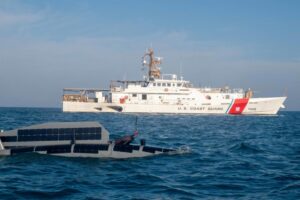A member of a National Academy of Sciences Transportation Research Board (TRP) told a congressional panel this week that the Coast Guard has only made partial progress on recommendations it made in a 2020 report on how the service can better leverage unmanned systems.
“Congress requested a study of the Coast Guard’s existing and prospective use of unmanned systems to fulfill its many critical missions. Through the course of that study, the committee recognized the value that such technologies could offer the Coast Guard. The committee made five recommendations related to unmanned systems,” Sean Pribyl, member of the Committee on Coast Guard Maritime Domain Awareness for the 2020 National Academy of Sciences Report, said on Sept. 19.

Pribyl was testifying before the House Committee on Transportation and Infrastructure, Subcommittee on Coast Guard and Maritime Transportation.
He said the 2020 report, called “Leveraging Unmanned Systems for Coast Guard Missions,” argued the Coast Guard should issue a high-level strategy, designate a senior champion, stand up a program office, expand and normalize experimentation and get a fix on funding needs (Defense Daily, Nov. 12, 2020).
Pribyl’s written testimony said the Coast Guard has only fully addressed the first of the five recommendations.
The report recommended the Commandant of the Coast Guard issue a high level unmanned systems (UxS) strategy to “articulate a compelling rationale for UxSs, set forth agency-critical goals that these systems should further, and outline the Coast Guard’s approach for achieving them,” Pribyl said.
In March, the service finally promulgated an Unmanned Systems Strategic Plan, “which appears to have addressed this recommendation,” Pribyl said.
In contrast, the other four pieces have had mixed results.
The committee recommended the Commandant designate a single top Coast Guard official to advocate for and advance its UxS strategy to better identify, promote, coordinate and facilitate changes to further unmanned strategic goals and objectives.
Pribyl said while the service has not designated an official to those ends, it appointed Capt. Thom Remmers as Unmanned Systems Lead.
He said this “should be viewed as a positive step that meets the intent of this recommendation,” in combination with the promulgation of the March unmanned systems plan by Vice Adm. Peter Gautier, Deputy Commandant for Operations.
The committee recommended a dedicated program office working with a high-level UxS advocate could help lead and coordinate the use of unmanned systems across Coast Guard forces as well as leverage relevant capabilities outside the service.
“The committee advised that an early initiative of the program office should be to develop a “roadmap” that translates the high-level UxS strategic goals and objectives into an actionable plan to accomplish them, which should specify tasks needing priority attention, time frames for completion, and performance metrics and milestones,” Pribyl said.
However, the service has not established this program office. Instead, it has developed a multi-program office autonomous policy committee, known as AutoPoCo, that meets periodically to discuss issues and attempts to offer a unified view.
Pribyl said that committee’s utility is limited because it “is not an avenue to which the public has direct access, and thus commercial entities are still expected to approach a multitude of offices to understand the parameters of lawful operations, ranging from Sector, District, and Headquarters offices.”
The report also recommended the Coast Guard expand and normalize systematic operations-related experimentation with low-cost UxS. Pribyl said the committee decided that encouraging UxS experimentation “will not only help to identify beneficial uses, but also nurture a technology-curious and -proficient workforce across the ranks.”
He noted the Coast Guard seems to have taken some steps in this direction as it participates in Navy experimentation with unmanned surface vessels (USVs) like at the Rim of the Pacific Exercise (RIMPAC).

He noted the service has used Saildrone USVs in support of research and development, but it is unclear if the vessels are required to comply with the international regulations for preventing collisions at sea (COLREGS).
“This is an important distinction…as the COLREGS apply to all vessels, and thus are critical to the Coast Guard as both a user and regulator of unmanned vessels.”
The U.S. 4th Fleet has started using Saildrone Voyager Unmanned Surface Vessels in its long-term operations testing in the Caribbean Sea region to help improve maritime domain awareness (Defense Daily, Sept. 15).
Last year, the Navy’s 5th Fleet announced it launched an Aerovel Flexrotor small vertical take-off and landing unmanned aerial system (UAS) from the Coast Guard cutter USCGC Emlen Tunnel (WPC-1145) in the the first such launch of a UAV from a Coast Guard cutter via Task Force 59 (Defense Daily, Dec. 15, 2022).
Task Force 59 is that fleet’s unit that is conducting experiments with unmanned systems in the region, which spurred Navy leadership to expand similar efforts to the 4th Fleet.
The final committee recommendation was that the service should develop a “detailed assessment of investment needs” to ultimately expand unmanned system research and development, concepts of operations and integration. This could help support sustained funding with a commitment to continuously increasing funding over the long term, Pribyl said.
“While the committee was not able to estimate and advise on how much additional funding would be required for these investments, it recommended the development of a detailed assessment of investment needs,” he said in his written testimony.
During the hearing, Pryble said the Coast Guard could get the most immediate value out of unmanned systems by using them for search and rescue and pollution response missions.
He argued that the report found a main issue for the Coast Guard gaining commercial access to platforms was the acquisition process.
“That it wasn’t moving quickly enough, that they didn’t have the mechanisms in place to avail themselves of that technology. And, in the United States, most of this technology is being developed on the commercial side. So, we had made some recommendations related to that.”